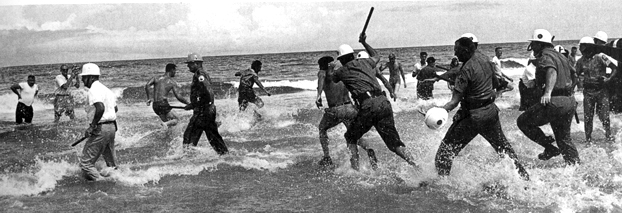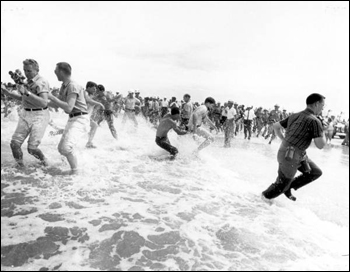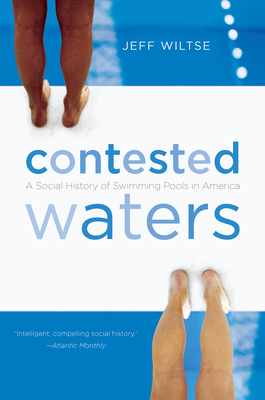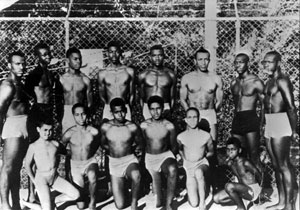Excerpt: Contested Waters, "Just Don't Touch the Water"FORT LAUDERDALE July 4, 1961 a small group of other civil rights activists waded into the whites-only beach off Las Olas Boulevard. The "wade-ins" that started that day were a turning point in Fort Lauderdale history. A year later, a judge refused the city's request to stop the protests and the city decided to open the beaches to everyone.
INTRODUCTION--In 1898 Boston's mayor Josiah Quincy sent Daniel Kearns, secretary of the city's bath commission, to study Philadelphia's bathing pools. Philadelphia was the most prolific early builder of municipal pools, operating nine at the time. All but three were located in residential slums and, according to Kearns, attracted only "the lower classes or street gamins." City officials had built the austere pools during the 1880s and early 1890s—before the germ theory of disease transmission was popularly accepted—and intended them to provide baths for working-class men and women, who used them on alternating days. The facilities lacked showers, because the pools themselves were the instruments of cleaning. Armed with the relatively new knowledge of the microbe, Kearns was disturbed to see unclean boys plunging into the water: "I must say that some of the street gamins, both white and colored, that I saw, were quite as dirty as it is possible for one to conceive." While the unclean boys shocked Kearns, blacks and whites swimming together elicited no surprise. He commented extensively on the shared class status of the "street gamins" and their dirtiness but mentioned their racial diversity only in passing. Nor did racial difference seem to matter much to the swimmers, at least not in this social context. The pools were wildly popular. Each one recorded an average of 144,000 swims per summer, or about 1,500 swimmers per day.

Fifty-three years later, the scene at a municipal pool in Youngstown, Ohio, was quite different. A Little League baseball team had won the 1951 city championship and decided to celebrate at the local pool. The large facility was situated within the sylvan beauty of the city's Southside Park, not in a residential slum. The pool itself was surrounded by a broad deck and grassy lawn, both of which provided swimmers ample space to play games or lie in the sun. The pool was clearly intended to promote leisure, not cleanliness. To celebrate their baseball victory, coaches, players, parents, and siblings showed up at the pool, but not all were admitted. One player, Al Bright, was denied entrance because he was black. The lifeguards forced him to sit on the lawn outside the fence as everyone else played in the pool. The unwritten rule was clear, one guard told the coach, "Negroes are not permitted in the pool area." After an hour had passed, several parents pleaded with the guards to let Al into the pool for at least a couple of minutes. Finally, the supervisor relented; Al could "enter" the pool as long as everyone else got out and he sat inside a rubber raft. As his teammates and other bystanders looked on, a lifeguard pushed him once around the pool. "Just don't touch the water," the guard constantly reminded him, "whatever you do, don't touch the water."

Cairo, Illinois
How is it that so much had changed in those fifty years? At its heart, this book answers that question. It explains how and why municipal swimming pools in the northern United States were transformed from austere public baths—where blacks, immigrants, and native-born white laborers swam together, but men and women, rich and poor, and young and old did not—to leisure resorts, where practically everyone in the community except black Americans swam together. As the opening vignettes suggest, this social, cultural, and institutional transformation occurred during the first half of the twentieth century and involved the central developments of the period: urbanization, the erosion of Victorian culture, Progressive reform, the emergence of popular recreation, the gender integration and racial segregation of public space, and the sexualization of public culture. In short, the history of swimming pools dramatizes America's contested transition from an industrial to a modern society.
![[Photographer unknown]](http://www.crmvet.org/crmpics/staug6.jpg)
June, 1964. Black children integrate the swimming pool of the Monson Motel. To force them out, the owner pours acid into the water.
But the story does not end there. A second social transformation occurred at municipal swimming pools after midcentury. Black Americans challenged segregation by repeatedly seeking admission to whites-only pools and by filing lawsuits against their cities. Eventually, these social and legal protests desegregated municipal pools throughout the North, but desegregation rarely led to meaningful interracial swimming. When black Americans gained equal access to municipal pools, white swimmers generally abandoned them for private pools. Desegregation was a primary cause of the proliferation of private swimming pools that occurred after the mid-1950s. By the 1970s and 1980s, tens of millions of mostly white middle-class Americans swam in their backyards or at suburban club pools, while mostly African and Latino Americans swam at inner-city municipal pools. America's history of socially segregated swimming pools thus became its legacy.

Throughout their history, municipal pools served as stages for social conflict. Latent social tensions often erupted into violence at swimming pools because they were community meeting places, where Americans came into intimate and prolonged contact with one another. People who might otherwise come in no closer contact than passing on the street, now waited in line together, undressed next to one another, and shared the same water. The visual and physical intimacy that accompanied swimming made municipal pools intensely contested civic spaces. Americans fought over where pools should be built, who should be allowed to use them, and how they should be used.

Integrating St. Augustine's "white only" beaches. "I remember the wade-ins because the bump hasn't gone off my jaw yet. They started yelling obscenities at us, but we went on — myself and a group of teen-age girls. We were afraid but we felt we just had to go on." — Dorothy Cotton, SCLC.
This is a very different view of urban space than presented by historians John Kasson, Kathy Peiss, and David Nasaw. They characterize commercial amusements at the turn of the twentieth century—such as Coney Island, dance halls, and movie houses—as social melting pots that rather painlessly dissolved earlier class and gender divisions but reinforced racial distinctions. According to Nasaw, "'going out' meant laughing, dancing, cheering, and weeping with strangers with whom one might—or might not—have anything in common. . . . Only persons of color were excluded or segregated from the audience." Kasson makes essentially the same point when he concludes that commercial amusements "help[ed] to knit a heterogeneous audience into a cohesive whole."

Woman by sign blown down during hurricane: Virginia Beach, Florida (1950). Virginia Beach is off the coast of Miami in Dade County.
Just the opposite was true at swimming pools early in the twentieth century. Northerners' use of municipal pools throughout the Progressive Era reinforced class and gender divisions but not racial distinctions. Cities strictly segregated pools along gender lines, and people from different social classes almost never swam together. In many cases, middle-class northerners fought vigorously to ensure that working-class swimmers did not intrude upon their recreation spaces. By contrast, blacks and working-class whites commonly swam together, often without conflict.

Segregationists trying to prevent blacks from swimming at a "White only" beach (June 25, 1964)
All this changed during the 1920s, when northerners redrew the lines of social division at municipal pools. Different social classes of whites and both sexes plunged into the same pools and simultaneously excluded black Americans. This social reconstruction had many causes. The Great Black Migration contributed to the onset of racial segregation at pools by intensifying residential segregation in northern cities and heightening perceptions of black- white racial difference. Conversely, economic prosperity and the decline in European immigration mitigated perceptions of class and ethnic difference. Middle-class northerners generally became willing to swim in the same pools with working-class whites because they did not seem as poor, foreign, or unhealthy as before. Also, municipal pools became more appealing to the middle class during the 1920s because cities redesigned them as leisure resorts and typically located them in open and accessible parks rather than residential slums. At the same time, municipal officials began permitting males and females to swim together because they intended the new resort pools to promote family and community sociability. The concerns about intimacy and sexuality that had necessitated gender segregation previously did not disappear during the 1920s; rather, they were redirected at black Americans in particular. Whites in many cases quite literally beat blacks out of the water at gender-integrated pools because they would not permit black men to interact with white women at such intimate public spaces. Thus, municipal pools in the North continued to be intensely contested after 1920, but the lines of social division shifted from class and gender to race.

Tallahassee, Florida: Swim team at Robinson Trueblood Swimming Pool on Dade Street was built by the city in response to wade-ins by blacks at all white pools. It was the only pool where blacks could swim and train as lifeguards.
The social reconstruction of municipal pools between 1920 and 1940 marked a fundamental shift in northern social values and patterns of social interaction. During the Gilded Age and Progressive Era, the difference between people with "black" skin and those with "white" skin was a less significant social distinction than class. Furthermore, what we now think of as "race" was a less significant public social division than gender, class, and even generation. That changed during the 1920s, when race emerged as the most salient and divisive social distinction. Northern cities became fundamentally more integrated along class, gender, and generational lines, yet more segregated along racial lines. This racial division persisted throughout the rest of the twentieth century, despite court-ordered desegregation and the civil rights movement.

Savannah, Georgia Beach July 15, 1963: Two Negroes were arrested by local police and jeered and cursed by white people on the beach for swimming in the whites only water.
Northerners also contested public culture at municipal pools. During the late nineteenth century, working-class boys battled with Victorian public officials to determine the use and function of these new institutions. Public officials intended municipal pools to be used "seriously" as baths and fitness facilities. They were supposed to instill the working classes with middle-class values and habits of life. In defiance of these expectations, working-class boys transplanted their boisterous and pleasure-centered swimming culture from natural waters and defined municipal pools as public amusements. In doing so, they undermined Victorian public culture and helped popularize the pleasure-centered ethos that came to define modern American culture. During the 1920s and 1930s, swimmers refashioned attitudes about the body and cultural standards of public decency by what they wore and how they presented themselves at municipal pools. City officials attempted to dampen the sexual charge sparked by mixed-gender use and to limit exhibitionism and voyeurism by mandating conservative swimsuits. They could not, however, control popular demand. The acceptable size of swimsuits shrank during the interwar years and pools became eroticized public spaces. As a result, public objectification of the body became implicitly acceptable, and public decency came to mean exhibiting an attractive appearance rather than protecting one's modesty. The female nakedness and overt sexuality that pervade contemporary American culture originated, in part, at swimming pools. In these ways, ordinary Americans reshaped public culture by what they did and what they wore at municipal pools.

Civil Rights Series, Demonstrations at an "all-white" swimming pool in Cairo, Illinois, 1962
Municipal swimming pools were extraordinarily popular during the 1920s, 1930s, and 1940s. Cities throughout the country built thousands of pools—many of them larger than football fields—and adorned them with sand beaches, concrete decks, and grassy lawns. Tens of millions of Americans flocked to these public resorts to swim, sunbathe, and socialize. In 1933 an extensive survey of Americans' leisure-time activities conducted by the National Recreation Association found that as many people swam frequently as went to the movies frequently. In other words, swimming was as much a part of Americans' lives as was going to the movies. Furthermore, Americans attached considerable cultural significance to swimming pools during this period. Pools became emblems of a new, distinctly modern version of the good life that valued leisure, pleasure, and beauty. They were, in short, an integral part of the kind of life Americans wanted to live.

This story of tens of millions of Americans flocking to municipal pools, reshaping cultural standards, and redefining the meaning of the good life presents a very different view of modern American culture than offered by most historians. William Leach, Gary Cross, and Richard Fox and T. J. Jackson Lears are unanimous in arguing that consumption and commercialism became the dominant cultural ethos in twentieth-century America, effectively wiping out all competing public cultures. In their introduction to The Culture of Consumption, Fox and Lears claim that "consumption became a cultural ideal, a hegemonic 'way of seeing' in twentieth-century America." Additionally, many cultural historians characterize Americans as passive receivers of this consumer culture supposedly created and popularized by marketers, movie producers, merchants, and entrepreneurs. As William Leach argues in Land of Desire, "the culture of consumer capitalism may have been among the most non-consensual public cultures ever created . . . it was not produced by 'the people' but by commercial groups in association with other elites." This was not the case at municipal swimming pools, where ordinary Americans helped create a vibrant public culture not primarily focused on spending money and consuming goods.
1964 Racial Confrontation on St. Augustine Beach. A confrontation of black demonstrators and white segregationists at a white-only beach in St. Augustine. (Photo: Florida State Archives)
Finally, the history of swimming pools reveals changes in the quality of community life and the extent of civic engagement in modern America. From the 1920s to the 1950s, municipal pools served as centers of community life and arenas for public discourse. Hundreds and sometimes thousands of people gathered at these public spaces where the contact was sustained and interactive. Neighbors played, chatted, and flirted with one another, but they also fought with one another over who should and should not be allowed to swim and what sorts of activities and clothing were appropriate for this intimate public space. In short, community life was fostered, monitored, and disputed at municipal pools. The proliferation of private swimming pools after the mid-1950s, however, represented a retreat from public life. Millions of Americans abandoned public pools precisely because they preferred to pursue their recreational activities within smaller and more socially selective communities. Instead of swimming, socializing, and fighting with a diverse group of people at municipal pools, private-pool owners fenced themselves into their own backyards. The consequences have been, to a certain extent, atomized recreation and diminished public discourse.

This study focuses on the history of municipal swimming pools in the northern United States. I chose to focus on municipal pools because they enabled me to study the public lives of Americans from many different — and often overlapping—social groups: working-class whites, women, African Americans, immigrants, children, and the middle class. At one time or another, Americans from all these social groups frequented municipal pools and contested their use. This book also examines and interprets the history of private swimming pools, but mostly when that history is necessary for understanding what occurred at municipal pools. I chose to focus on the northern United States in order to make the research more manageable, and because I wanted to tell a coherent story rather than interpret regional variation. I have, however, defined the northern United States broadly, including cities such as Baltimore, Washington, D.C., and St. Louis. These cities certainly have a southern heritage, but the history of their municipal pools followed a very similar pattern to that of cities further north. Likewise, the pattern occurred not only in large cities but in smaller municipalities as well. It turns out that what happened at municipal pools, whether in St. Louis and Chicago or in Newton, Kansas, and Elizabeth, New Jersey, was all quite similar.
[From Contested Waters: A Social History of Swimming Pools in America by Jeff Wiltse. Copyright (c) 2007 by the University of North Carolina Press.]




First of all I would like to say great blog! I had a quick question that I'd like to ask if you do not mind. I was interested to find out how you center yourself and clear your head before writing. I've
ReplyDeletehad a difficult time clearing my mind in getting my thoughts out there.
I truly do enjoy writing but it just seems like the first 10 to 15
minutes are generally wasted just trying to figure out how to begin.
Any recommendations or hints? Thanks!
My web page - air conditioning Johannesburg
Fastidious answer back in return of this query with genuine arguments and explaining the whole thing regarding that.
ReplyDeleteFeel free to surf to my web-site :: business branding and printing
Hi I am so delighted I found your webpage, I really found you by
ReplyDeleteaccident, while I was looking on Digg for something else, Anyways I am here now and would just like to say thank
you for a fantastic post and a all round enjoyable blog (I also love the theme/design), I don’t have time to go through it all at the moment but I have saved it and also included your RSS feeds, so when I have time I will
be back to read much more, Please do keep up the awesome jo.
Here is my homepage garage equipment supplier
Very nice article, exactly what I needed.
ReplyDeleteHere is my web-site; mine overseers ticket
Post writing is also a fun, if you be familiar with after that you can
ReplyDeletewrite otherwise it is complicated to write.
Also visit my homepage ... key holders Durban
Hey very nice blog!
ReplyDeleteHere is my homepage :: security
Pretty! This was a really wonderful post. Thanks
ReplyDeletefor providing this information.
Here is my webpage; Document Imaging
Today, I went to the beach with my children. I found a sea shell and gave it to my 4 year old daughter
ReplyDeleteand said "You can hear the ocean if you put this to your ear." She put the shell to her ear and screamed.
There was a hermit crab inside and it pinched her ear. She never wants to go back!
LoL I know this is totally off topic but I had to tell someone!
Review my webpage ... signage Bloemfontein
Excellent blog! Do you have any tips and hints for aspiring writers?
ReplyDeleteI'm planning to start my own website soon but I'm a little
lost on everything. Would you propose starting with a free platform like Wordpress or go for a paid option?
There are so many choices out there that I'm completely
overwhelmed .. Any tips? Kudos!
Review my web site; Swimming STrokes
only one question wrong again. I wouldn't say I'm breezing through - I'm working hard for my good results.cedar fence boards
ReplyDelete